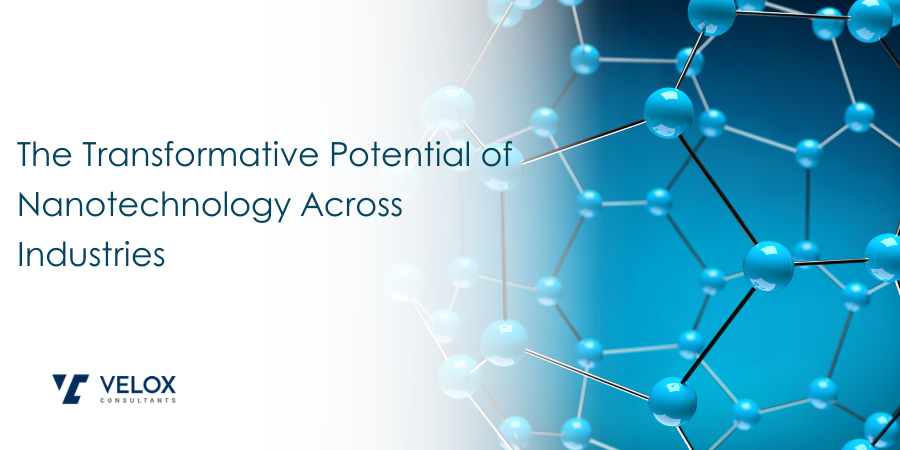Introduction
Nanotechnology, which involves manipulating matter at the nanoscale (one billionth of a meter), is set to revolutionise various sectors, including healthcare, energy, and manufacturing. This technology offers significant advancements in efficiency, performance, and sustainability. Exploring nanotechnology's implications, current applications, potential, and challenges is important.
The global nanotechnology market is not just growing rapidly, but it's also reshaping our world. Healthcare, electronics, energy, and materials science advancements are all driven by nanotechnology.

The global nanotechnology market, a testament to the technology's relevance and potential, is projected to exceed US$120 billion by 2030. This growth, with an estimated compound annual growth rate (CAGR) of more than 30% from 2024 to 2030, is driven by increasing investments in research and development, rising demand for miniaturised devices, and the expanding applications of nanotechnology across various industries.
Perspectives from Experts and Government Officials
Government initiatives worldwide, such as the Department of Science and Technology (DST) in India and the National Nanotechnology Initiative (NNI), underscore nanotechnology's strategic importance and transformative potential. These initiatives establish their countries as global leaders by encouraging innovation and collaboration among research institutions, industries, and government agencies.
Industry experts emphasise nanotechnology's transformative potential across disciplines.
- Dr. Raghunath Mashelkar, former Director-General of the Council of Scientific and Industrial Research (CSIR), emphasises the cross-disciplinary applications of nanotechnology. He notes that nanotechnology is not confined to a single industry but spans healthcare, agriculture, energy, and beyond. Its potential to revolutionise product design and improve efficiency is unparalleled.
- Dr. Chad A. Mirkin, a leading nanotechnology expert and professor at Northwestern University, has significantly contributed to the field. His inventions, such as Spherical Nucleic Acids (SNAs) and Dip-Pen Nanolithography (DPN), have advanced diagnostics, gene therapies, and materials science. His research on nanoparticle-based diagnostics and nanomedicine has revolutionised early disease detection and targeted drug delivery. Moreover, his advocacy for nanotech education and policy has shaped national funding priorities, significantly impacting healthcare, industry, and scientific innovation.
The Current State of Nanotechnology
Recent advances in nanotechnology have showcased its remarkable versatility and potential for transformation in several key areas:
- Healthcare: Scientists at MIT have developed a new type of nanoparticle to enhance vaccine effectiveness. These metal-organic frameworks (MOFs) encapsulate and transport viral proteins while acting as an adjuvant, boosting the body's immune response more effectively than traditional methods.
- Regenerative Medicine: King Abdullah University of Science & Technology (KAUST) researchers have created nanowire scaffolds that promote bone formation. These nanowires can expedite tissue repair when exposed to magnetic fields, opening up new possibilities for addressing degenerative bone diseases.
- Environmental Applications: Microrobots capable of removing microplastics and bacteria from water contribute to tackling pollution and disease spread in aquatic environments. Moreover, laser-treated cork is being utilised to absorb oil spills, aiding in the effort to create cleaner oceans and implement carbon-neutral solutions.
Challenges and Barriers
Nanotechnology has great potential but encounters several challenges:
- Scalability: The transition of nanotechnology from the laboratory to industrial production while maintaining quality and consistency is a significant obstacle.
- Safety and Environmental Impact: The small size of nanomaterials may result in unexpected interactions with biological systems and the environment. Ensuring the safe use and disposal of nanomaterials is crucial to mitigate potential risks.
- Regulatory Framework: The regulatory landscape for nanotechnology is still developing. Clear guidelines and standards are needed to ensure safe development and application while fostering innovation.
- Public Perception and Ethical Concerns: Addressing concerns about potential risks and ethical implications of manipulating matter at the nanoscale is essential for gaining public trust.
Emerging Trends

Nanotechnology in Healthcare
Targeted Drug Delivery Systems: Nanotechnology is revolutionising drug delivery by enabling precise targeting of diseased cells, minimising side effects, and enhancing treatment efficacy. Nanoparticles are engineered to deliver drugs directly to cancer cells, bypassing healthy tissues. This method improves the concentration of the drug in the target area, enhancing its effectiveness.
- Doxil, a liposomal formulation of doxorubicin, exemplifies this trend. Doxil's nanoparticle design allows it to evade the immune system and deliver the chemotherapy drug directly to tumour sites, significantly reducing side effects compared to traditional chemotherapy.
- Indian Institute of Science (IISc) researchers have developed a nanoparticle-based delivery system for tuberculosis (TB) treatment. This innovation targets the TB bacteria more effectively, reducing the treatment duration and improving patient compliance.
Nanodiagnostics: Nanotechnology enhances diagnostic capabilities through nanodiagnostics, using nanoparticles and nanosensors for early and precise disease detection. These tools identify biomarkers at low concentrations, enabling early intervention.
- Nanosensors have been used for early detection of cancer and infectious diseases. For example, researchers at the Massachusetts Institute of Technology (MIT) developed a paper-based diagnostic test using gold nanoparticles to detect the Ebola virus in minutes.
- The Indian startup Nanobiosym has developed Gene-RADAR®, a nanodiagnostic platform capable of real-time detection of genetic mutations and pathogens. This device can diagnose diseases like malaria, HIV, and COVID-19 at the point of care, providing rapid and accurate results.
Regenerative Medicine: Nanotechnology advances regenerative medicine by creating nanomaterials that promote tissue repair and regeneration. Nanostructured scaffolds and nanoparticles stimulate stem cell growth and differentiation, aiding in regenerating damaged tissues and organs.
- Researchers in the UK have developed a graphene-based scaffold that supports the growth of neural stem cells, potentially aiding in treating spinal cord injuries and neurodegenerative diseases.
- The National Institute of Pharmaceutical Education and Research (NIPER) in Mohali has been working on nanofiber scaffolds for bone tissue engineering. These scaffolds, made from biocompatible nanomaterials, facilitate the growth of new bone tissue, offering new hope for patients with bone injuries and degenerative bone diseases.
Nanorobots for Surgery and Treatment: Nanorobots, also known as nanobots, are miniature machines capable of performing precise surgical procedures and delivering drugs to specific body parts. These robots can navigate the human body, offering minimally invasive options for complex surgeries.
- Researchers at the National Institute of Technology (NIT) are developing nanobots for targeted drug delivery in brain cancer treatments.
- Internationally, nanorobots are being explored by institutions like Harvard University's Wyss Institute, which is developing nanobots that can perform surgical tasks at the cellular level.
Nanotechnology in Defence
Enhanced Protective Gear and Materials: Nanotechnology has revolutionised the development of lightweight, durable, and multifunctional materials for military applications. These advanced materials enhance protection against ballistic impacts, chemical and biological threats, and extreme environmental conditions. For example, fabrics infused with carbon nanotubes can offer superior ballistic resistance while maintaining flexibility and comfort.
- The U.S. Army developed a nanomaterial-based body armour called the "Dragon Skin," which uses a lattice of ceramic discs within a nanocomposite matrix. This innovative armour significantly improves soldiers' survivability by providing enhanced protection against bullets and shrapnel while reducing weight.
Improved Weaponry and Munitions: Nanotechnology improves the performance and efficiency of weapons and munitions, resulting in increased precision, range, and lethality. Nanoscale coatings and materials can enhance the durability and effectiveness of explosives, propellants, and guidance systems. For instance, integrating nanothermites, which are nanoparticles of reactive metals, into conventional explosives significantly enhances their explosive power and precision.
- DARPA's (Defense Advanced Research Projects Agency) Excalibur program highlights the use of nanotechnology to develop guided artillery shells with improved accuracy. These shells use nanoscale materials to enhance propulsion and guidance, achieving higher precision and effectiveness in targeting enemy assets.
Advanced Surveillance and Reconnaissance: Nanotechnology enables the development of highly sensitive and miniaturised sensors for advanced surveillance and reconnaissance missions. These nanosensors can detect chemical, biological, radiological, and nuclear (CBRN) threats accurately and in real-time. They can also be integrated into various platforms, including drones, satellites, and wearable devices.
- The deployment of nanotechnology-based sensors in the "Black Hornet" nano-drone used by several military forces, including the British Army. These tiny drones, equipped with nanosensors, provide real-time battlefield intelligence, enabling soldiers to conduct covert surveillance, detect threats, and gather critical information without exposing themselves to danger.
Nanotechnology in Agriculture
Nano-Fertilizers and Nano-Pesticides: Nano-fertilizers and nano-pesticides are transforming agriculture by improving the efficiency of nutrient and pesticide delivery systems. These nanoscale formulations enhance plant uptake of nutrients and active ingredients, resulting in higher crop yields and reduced environmental impact.
- The Indian Council of Agricultural Research (ICAR) has been experimenting with nano-fertilisers, demonstrating significant yield improvements in rice and wheat.
- Globally, researchers at Wageningen University in the Netherlands have developed nano-pesticides that target specific pests, reducing the need for broad-spectrum chemical applications and minimising ecological damage.
Nanosensors for Precision Agriculture: Nanosensors are revolutionising precision agriculture through real-time monitoring of soil health, crop growth, and environmental conditions. These sensors can detect nutrient levels, moisture content, and the presence of pathogens, enabling farmers to make informed decisions about irrigation, fertilisation, and pest control.
- The National Institute of Agricultural Research Management (NIARM) has been developing nanosensor technologies for soil health monitoring, which are being tested in various agricultural regions.
- In the United States, the University of California, Davis, has integrated nanosensors into smart farming systems, resulting in more efficient resource use and improved crop management practices.
Nano-Enabled Seed Treatments: Nano-enabled seed treatments involve coating seeds with nanoparticles to protect them from diseases and enhance their growth potential. These treatments can include antimicrobial agents, growth promoters, and nutrient carriers, providing seedlings a better start and improving overall plant health.
- Tamil Nadu Agricultural University has developed nano-coated seeds that show increased germination rates and resistance to fungal infections.
- Globally, companies like Syngenta invest in nano-seed treatments to boost crop performance and sustainability. For example, their nano-enabled seed treatments have shown promising results in increasing maise yields in African countries, contributing to food security.
Nanotechnology in Energy: Green, Carbon, and Materials
Green Energy Solutions: Nanotechnology is revolutionising green energy by enhancing the efficiency of solar cells. Quantum dots, a type of nanomaterial, can be tuned to absorb different parts of the solar spectrum, resulting in higher energy conversion rates.
- Tata Power Solar has been exploring quantum dot solar cells in India to improve energy output and reduce costs.
- Globally, the Massachusetts Institute of Technology (MIT) has developed a solar cell using perovskite quantum dots that achieves a conversion efficiency of over 25%, making significant strides towards more sustainable solar energy solutions.
Carbon Nanotubes for Energy Storage: Carbon nanotubes (CNTs) are critical in advancing energy storage technologies, such as batteries and supercapacitors. CNTs have exceptional electrical conductivity and surface area, which improve energy storage capacity and charge/discharge rates.
- Indian Oil Corporation has been researching CNT-based supercapacitors to enhance the efficiency of electric vehicle batteries.
- On the global front, Tesla has incorporated CNTs in their battery technology, leading to batteries with higher energy density and faster charging times, crucial for the widespread adoption of electric vehicles.
Advanced Materials for Energy Efficiency: Nanomaterials create advanced insulation materials, significantly reducing building energy consumption. Aerogels, a type of nanomaterial, offer superior thermal insulation properties.
- Thermax Limited has been utilising aerogel-based insulation to improve energy efficiency in industrial processes.
- Internationally, NASA employs aerogels for insulation in space missions, demonstrating their effectiveness in extreme conditions and paving the way for their application in energy-efficient building materials on Earth.
Nanotechnology in Manufacturing
Nanomaterials: Nanomaterials such as carbon nanotubes, graphene, and nanocomposites revolutionise manufacturing by providing superior strength, lightweight properties, and enhanced electrical and thermal conductivity.
- In India, Tata Steel is leveraging nanomaterials to develop high-performance steel with improved strength-to-weight ratios, enhancing product durability and reducing material costs.
- Globally, Boeing utilises carbon nanotubes in aircraft components to achieve lighter structures, leading to significant fuel efficiency and reduced emissions.
Nano-Coatings for Improved Durability: Nano-coatings are being applied to various manufacturing processes to improve product lifespan and resistance to wear and corrosion.
- Berger Paints has developed nano-coatings for automotive and industrial applications, offering enhanced protection against environmental factors.
- Internationally, PPG Industries uses nanotechnology in coatings for the aerospace industry, ensuring extended durability and reduced maintenance for aircraft components.
Precision Manufacturing with Nanotechnology: The advent of nanotechnology is driving advancements in precision manufacturing, enabling the creation of components with nanoscale accuracy.
- Bharat Heavy Electricals Limited (BHEL) employs nanotechnology to produce high-precision turbine blades, increasing efficiency and performance.
- On a global scale, Intel integrates nanotechnology into semiconductor fabrication, producing microprocessors with smaller, faster, and more energy-efficient transistors.
Nanotechnology in Additive Manufacturing: Additive manufacturing, or 3D printing, is significantly enhanced by nanotechnology, allowing for the production of complex structures with superior mechanical properties.
- Objectify Technologies are exploring nanomaterials to improve the strength and functionality of 3D-printed parts.
- In the global arena, GE Additive is incorporating nanomaterials into its 3D printing processes to produce lightweight and robust components for the aerospace and medical industries.
Sustainable Manufacturing through Nanotechnology: Nanotechnology is contributing to more sustainable manufacturing practices by enabling the use of fewer raw materials and reducing waste.
- Aditya Birla Chemicals is developing Nano catalysts that enhance chemical reactions, reducing energy consumption and emissions.
- Internationally, BASF is utilising nanotechnology to create more efficient catalytic converters for automotive applications, helping to lower environmental impact and improve fuel efficiency.
Nanotechnology in Semiconductors
Quantum Dots for Next-Generation Displays: Quantum dots, semiconductor nanocrystals with unique optical properties, are being integrated into display technologies to achieve brighter, more vibrant, and energy-efficient screens.
- Samsung's QLED TVs, which utilise quantum dot technology, have set new standards in display quality. Quantum dots offer precise control over light emission, enhancing colour accuracy and reducing power consumption.
- In India, Reliance Jio is investing in quantum dot research to develop advanced display solutions for its consumer electronics segment, positioning itself at the forefront of this nanotechnology trend.
Nanofabrication Techniques for Smaller, More Powerful Chips: Advancements in nanofabrication techniques, such as extreme ultraviolet (EUV) lithography, enable the production of smaller, more powerful semiconductor chips. These techniques allow for the precise patterning of nanoscale features, leading to increased transistor density and improved performance.
- TSMC's 3nm process technology, utilising EUV lithography, is a prime example of how nanofabrication pushes the boundaries of semiconductor manufacturing.
- In India, the Semiconductor Laboratory (SCL) in Chandigarh is working on adopting nanofabrication methods to enhance its semiconductor fabrication capabilities, aiming to contribute to the global semiconductor supply chain.
Perspectives
Nanotechnology is revolutionising industries with its efficient, high-performance, and sustainable advancements. Governments worldwide are investing in nanotechnology to stimulate innovation and economic growth. This groundbreaking technology significantly impacts various sectors, creating substantial business opportunities. Nanotechnology enables precise and targeted drug delivery systems and advanced diagnostics in healthcare. For example, nanoparticles can deliver medications directly to cancer cells, reducing side effects and improving treatment efficacy. Similarly, nanosensors are being used for early disease detection, which can significantly enhance patient outcomes. These advancements are creating new markets for more effective and personalised medical treatments.
In the energy sector, nanotechnology is improving the efficiency of solar cells and energy storage solutions. Quantum dot solar cells and carbon nanotube-based batteries offer higher energy conversion rates and better performance, leading to more sustainable and cost-effective energy solutions. This creates opportunities for businesses to invest in green energy technologies and products.
Agriculture benefits from nanotechnology through innovations such as nano-fertilisers and nanosensors. These technologies improve crop yields and enable precision farming, which reduces environmental impact and increases efficiency. Companies in the agricultural sector can use these advancements to develop more effective products and sustainable farming practices.
Overall, nanotechnology drives growth and creates new business opportunities across multiple industries, from healthcare and energy to agriculture and beyond. Investing in nanotechnology can position businesses at the forefront of innovation and market expansion.
In the fast-paced business world, staying ahead of the competition requires timely and accurate insights. Velox Consultants has recently launched real-time market research services that deliver just that—providing actionable intelligence as events unfold. Whether it's monitoring industry trends, analysing competitor activities, or understanding consumer preferences, our comprehensive market monitoring and consumer insight services ensure you have the data you need right when needed. This immediate access to up-to-the-minute data empowers your strategic moves and gives you a competitive edge in a constantly evolving market landscape.
Contact us at consult@veloxconsultants.com to learn more about our real-time market research services.





